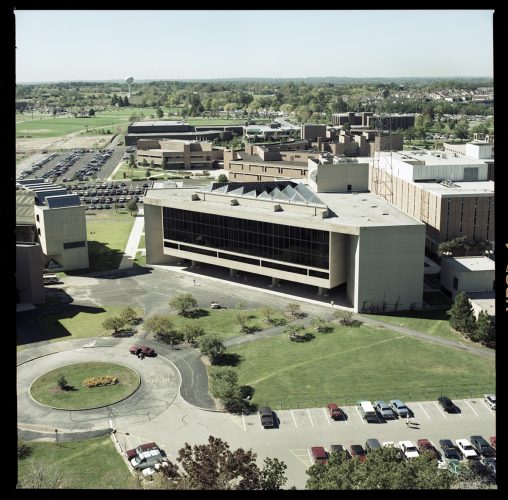
This year, Wright State celebrates its 50th anniversary as an independent public university, culminating with a special Homecoming celebration Sept. 29 through Oct. 1. The 1990s brought a growth spurt for Wright State, as the university opened seven buildings opened, three centers and Alumni Field. (Photos courtesy of Wright State Special Collections and Archives/CORE Scholar)
The 1990s brought a growth spurt for Wright State. Seven buildings opened, as well as three centers, and Alumni Field was dedicated.
The first building opened in the decade was the Wright State Nutter Center. In its first seven months, the Nutter Center booked 120 events. Since then, it has continued to be a stop on many major concert tours. When it isn’t hosting concerts or shows, it is the home of the Wright State men’s and women’s basketball teams.
In 1992, when Wright State celebrated its 25th anniversary, The Kellogg Foundation announced a $2 million grant to the College of Nursing and Health to fund The Partners for Community Health Development Project, which was designed to improve health care delivery to underserved residents and train health care professionals.
The Russ Engineering Center also opened in 1992. Today, Russ houses the College of Engineering and Computer Science, where students can expect access, affordability and preeminence.
The Center for Teaching and Learning opened in 1993. It offers programs and assistance to faculty for improving teaching, as well as aiding faculty members in creating accessible content for their classes. In the same year, the Women’s Center opened. The Women’s Center transforms the community by advocating for equity, eliminating gender-based barriers and providing diverse educational opportunities for the benefit of all.
In 1994, Harley Flack became the university’s fourth president and the first African-American president of a major metropolitan university in Ohio. Flack stressed collaboration and community building, both within and outside the campus walls. He forged a proactive relationship between Wright State and Dayton Public Schools to improve educational opportunities for all children. In addition, the state of Ohio provided Wright State money to help fund educational services to support students with disabilities. Flack died on March 29, 1998.
Flack was succeeded by Kim Goldenberg, who joined the university as chief of the General Internal Medicine division in 1983, eventually serving as dean of the medical school from 1990 to 1998. During his tenure as the university’s president, Wright State experienced tremendous transformation, including the creation of a nationally recognized first-year student experience, a broader and more innovative research enterprise, one of the strongest enrollment growth rates in the state and a successful fundraising campaign.
In 1994, the Student Union, which merged the former University Center with a physical education building, opened. Two years later, a $14 million campus master plan laid the groundwork for improved campus aesthetics, parking, recreation and pedestrian and vehicle traffic patterns.
The Asian, Hispanic and Native American Center opened in 1997, serving as a gathering place and information center for the Asian Student Association and the Association of Native American Students. Later, the organization split in two, creating the Asian and Native American Center and the Office of Latino Affairs.
Alumni Field, Wright State’s soccer venue, was dedicated in 1999.
University College was created, providing access, guidance and academic support to first-year, transfer and adult students.
“Turning Points,” a defining piece of artwork by sculptor David Black, was installed on campus in 1999.
Wright State became an independent institution in 1967 and has grown into an innovative leader in the Dayton region and beyond, capturing the spirit of the university’s namesakes, Wilbur and Orville Wright, who invented the world’s first successful airplane from their Dayton bicycle shop. It celebrates its 50th anniversary as an independent public university in 2017, culminating with a special Homecoming celebration Sept. 29 through Oct. 1.
















 Wright State psychology team studies ways to identify fatigue in pilots, drivers
Wright State psychology team studies ways to identify fatigue in pilots, drivers  Wright State videographer Kris Sproles wins Regional Emmy and Ohio journalism award
Wright State videographer Kris Sproles wins Regional Emmy and Ohio journalism award  Wright State Boonshoft School of Medicine ranked among the nation’s best for 2024 by U.S. News
Wright State Boonshoft School of Medicine ranked among the nation’s best for 2024 by U.S. News  Exposing biotechnology
Exposing biotechnology  Wright State faculty member Dan Noel uses unique background to inspire new leaders
Wright State faculty member Dan Noel uses unique background to inspire new leaders 